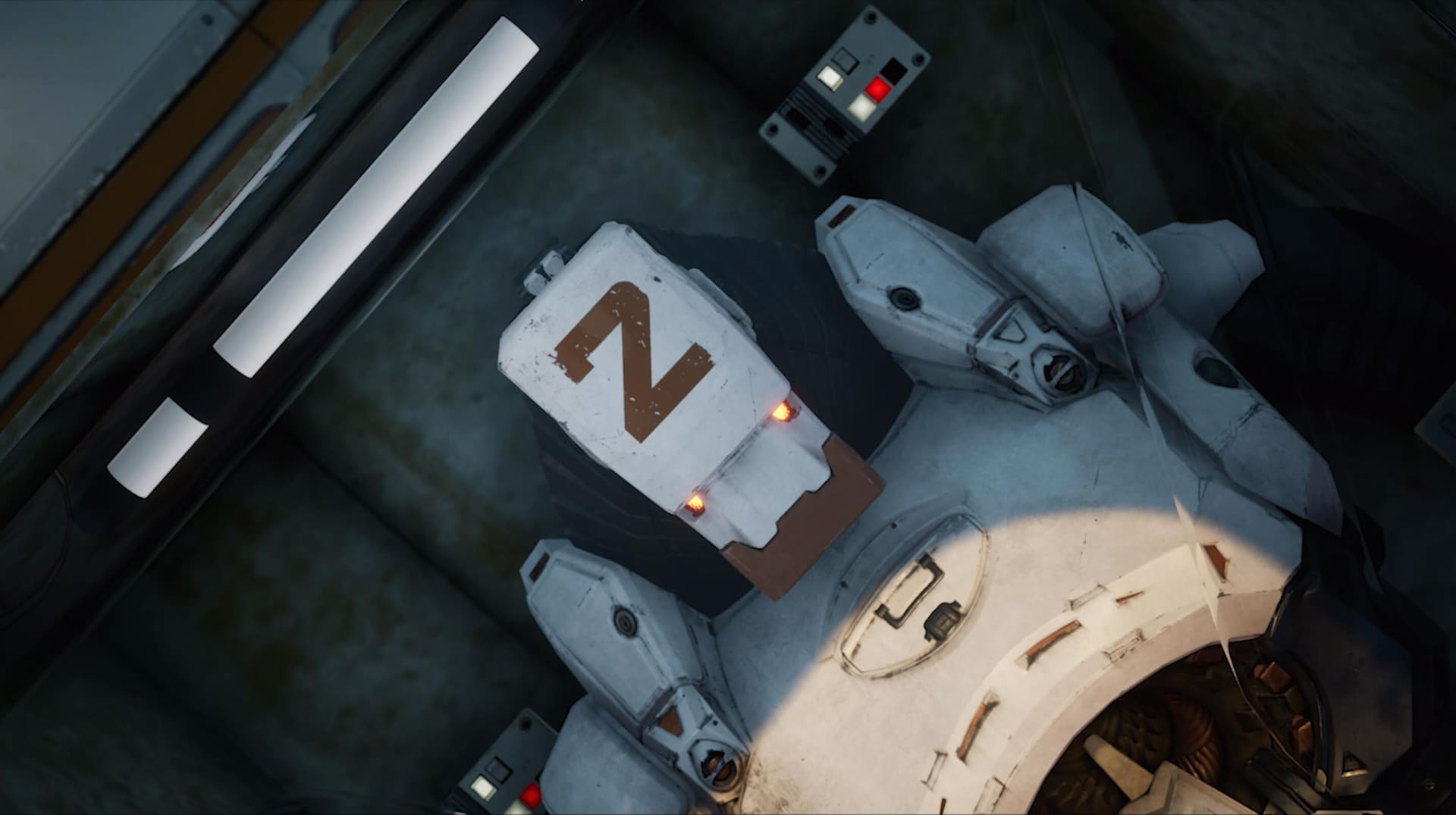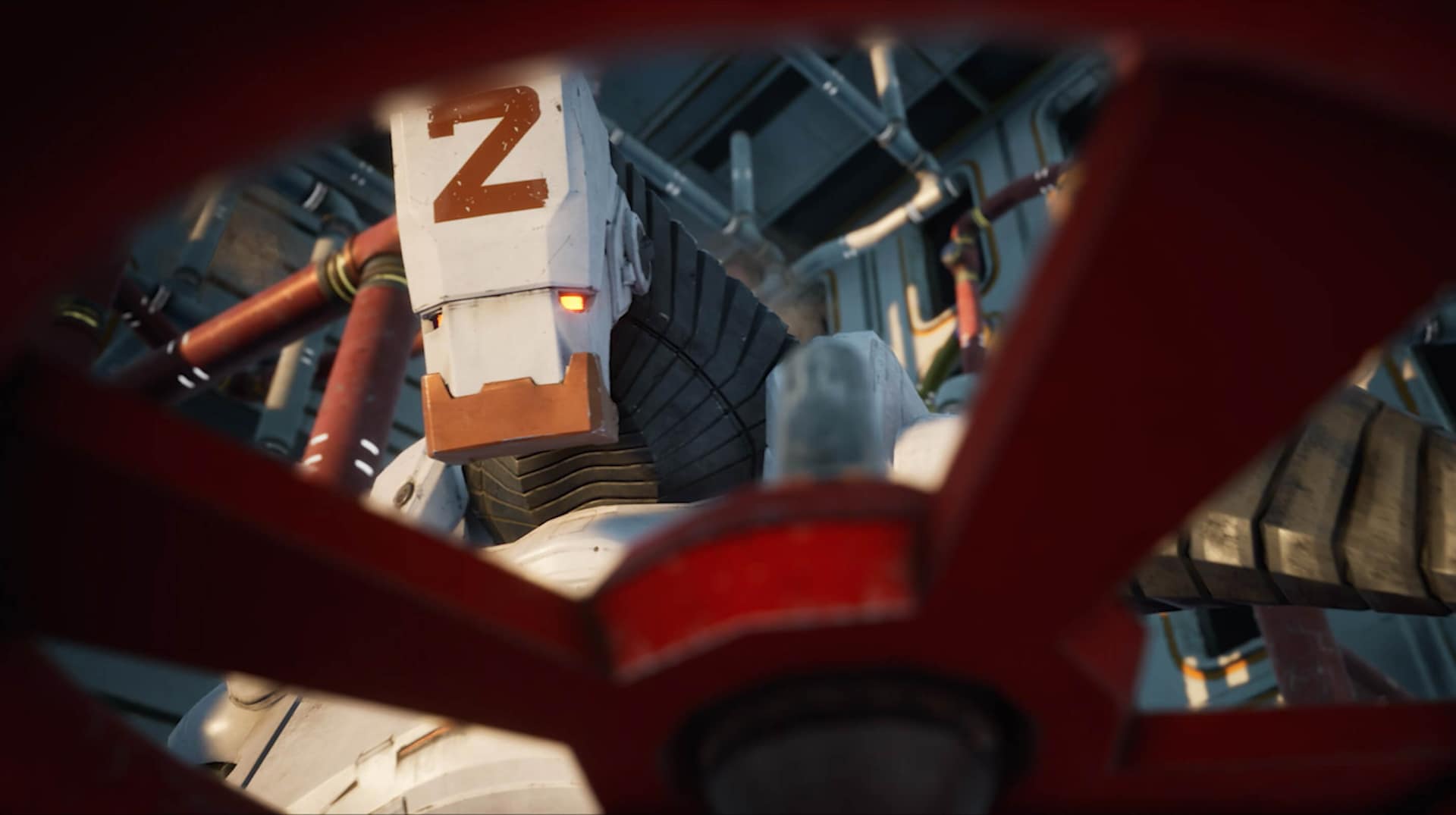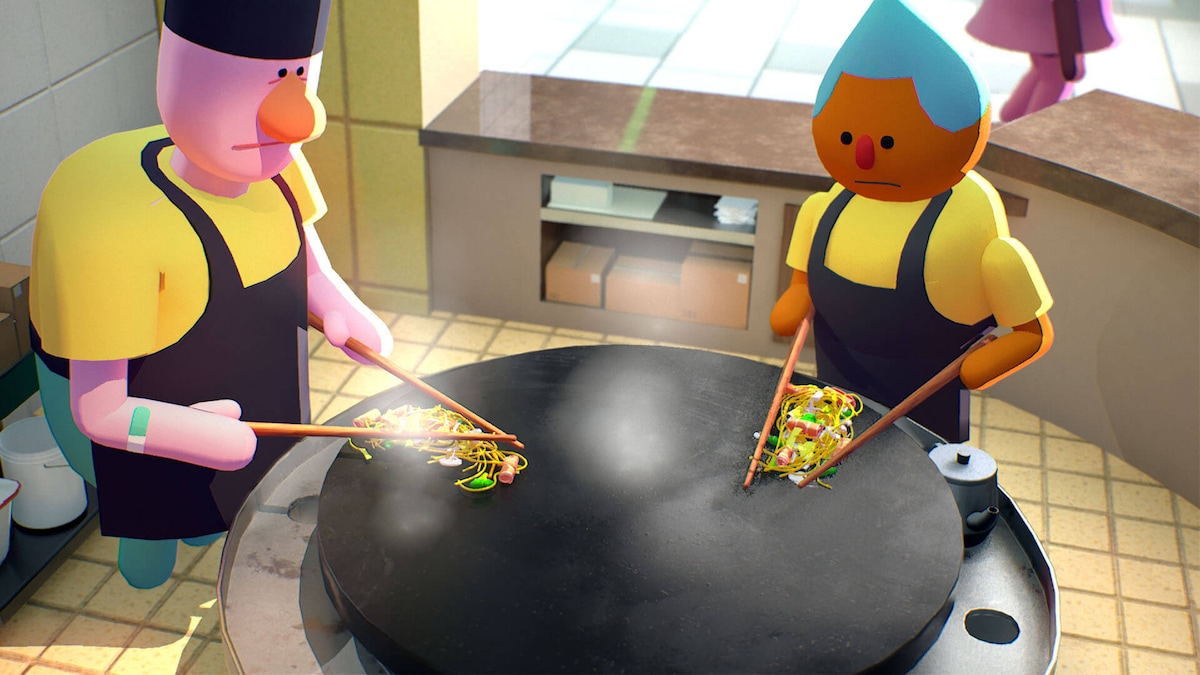
Image courtesy of Emre Okten
Explore three animated shorts from Fortnite’s film festival
1 de julio de 2022
Fortnite’s recent Short Nite film festival saw ten short animated movies screened in game, three of which were world premieres. We caught up with some of the filmmakers featured in the event to get the inside story on how they used Unreal Engine in their animation process.
Little Bird
Packed full of pathos, animated short Little Bird follows a brave young astronaut as she wrestles with a heart-wrenching choice. The themes explored in the film reflect challenges Chris Perry has faced in his own life. As the writer, director, and founder of Bit Films explains, he moved to Los Angeles in fall of 2019 for work, leaving his family behind on the other side of the country.“It was very hard for me to be away from them, especially my teenage daughter who was still living at home,” says Chris. “Little Bird is all about a dad and a daughter who want to be reunited across a great divide. The story came to me only a few weeks after I moved and, I’m sure, was a way for me to cope with the regret I felt having left them behind.”
The project was the first that Chris had completed using Unreal Engine. He and his colleague Raf Anzovin had been working on a custom pipeline for creating stylized CG that involved multiple render passes and a custom rigging system. After hearing about the Epic MegaGrants program, they successfully applied for funding, which they used to migrate that pipeline to Unreal Engine.
“The Epic MegaGrant made all the difference on this project,” says Chris. “The resources we received from the MegaGrant allowed us to build an incredible crew and take the time needed to do the project the way we wanted to do it.”

Image courtesy of Chris Perry
For the first few weeks of lighting on the project, Chris worked the way he had learned back at Pixar over 20 years ago. “I would pick a representative frame, then tweak lighting settings until I liked what I saw,” he says. “And then I remembered: I could just hit play. So I did. And I started tweaking my lights while looking at final-quality renders in real time. No more needing to hope that the changes would work on all frames; I could see them unfolding before my eyes! In general, being able to make adjustments to camera, lights, and set without disrupting the pipeline is incredibly freeing, creatively.”
Image courtesy of Chris Perry
Chris believes other animators thinking about dabbling in Unreal Engine for animation for the first time should just dive straight in. “Pick an actual shot or a contained short film and commit to making it,” he says. “Tutorials will never teach you as much as immersing yourself into the ecosystem full tilt.”

Image courtesy of Chris Perry
And as for himself, having had a taste of the benefits of real-time workflows for animation, Chris has become something of a convert. “I’m actively at work on a series project right now that’s using Unreal Engine, and I hope to stick with real-time tools for good!” he says.
Two
Two is a poignant snapshot of the friendship between two robots as their one-way mission to the sun nears its end. The animated short film was created by director and cinematographer Emre Okten.Emre is something of a real-time native. He's never used traditional animation tools, opting to jump straight into real-time engines four years ago when he was a student taking the motion capture class at USC. “Live-action filmmaking can be very arduous, so experimenting and exploring ideas in a game engine is very freeing,” he says. “It's an addictive, creative freedom.”

Image courtesy of Emre Okten
The film was originally a small side project. “I was a novice in the engine, so I knew I had to keep it simple if I wanted to complete it,” explains Emre.
That need for simplicity informed many of the foundational creative decisions, including setting the story in space, which enabled Emre to use isolated characters, limited environments, and robots as the principal characters, with no need to animate faces or fingers.
That need for simplicity informed many of the foundational creative decisions, including setting the story in space, which enabled Emre to use isolated characters, limited environments, and robots as the principal characters, with no need to animate faces or fingers.

Image courtesy of Emre Okten
Emre used motion capture techniques for the characters’ movements. Optical motion capture was directed to MotionBuilder through Motive, and MotionBuilder was live linked to Unreal Engine.
As part of a new wave of filmmakers, it’s perhaps no surprise that Emre has a strong belief in the potential of motion capture and photogrammetry. “These technologies are interesting, because they are the starting point of a futuristic effort to replicate physical reality in the digital,” he says. “They not only make it easier to build digital worlds, they provide ways to interact with them naturally as well.”
As someone who dived straight into game engines to make films, Emre provides an interesting perspective on this new, modern way of filmmaking. “Working in real-time is a great way for beginners and independent filmmakers to start making films,” he says. “Since Two, I have used the engine extensively at work, and I’m making a new short film in Unreal Engine as well. I also use it for prototyping ideas—just throw a few things together, make a few images, and get the idea out quickly. It’s great!”
As part of a new wave of filmmakers, it’s perhaps no surprise that Emre has a strong belief in the potential of motion capture and photogrammetry. “These technologies are interesting, because they are the starting point of a futuristic effort to replicate physical reality in the digital,” he says. “They not only make it easier to build digital worlds, they provide ways to interact with them naturally as well.”
As someone who dived straight into game engines to make films, Emre provides an interesting perspective on this new, modern way of filmmaking. “Working in real-time is a great way for beginners and independent filmmakers to start making films,” he says. “Since Two, I have used the engine extensively at work, and I’m making a new short film in Unreal Engine as well. I also use it for prototyping ideas—just throw a few things together, make a few images, and get the idea out quickly. It’s great!”

Image courtesy of Emre Okten
He has some sage advice for other animators and students thinking about experimenting with Unreal Engine for animation. “Game engines are an ocean, so it’s a good idea to have an idea, a specific project you want to make, that will give you direction and determine your learning path through the ocean,” he says. “Other than that, be aware of your limitations, use them to your advantage, and go for it!”
Mall Stories
In documentary-style short Mall Stories, we meet the endearing staff of a fictional food court inspired by real-life eatery Atilla the Grilla. The animated film was created by Elizabeth Ito, creator of the Peabody award-winning hit Netflix series City of Ghosts, who drew inspiration for the main characters from real people working at a real Mongolian Grill in Burbank Town Center.“I’m genuinely interested in stories of real people, as told by them,” says Elizabeth. “There’s nothing I can write that ever comes close, in my opinion. When you combine the documentary approach with my general design and storytelling style, there is a maximization of charm that isn’t achievable in live action.”
Mall Stories is the first project Elizabeth has used Unreal Engine on. “I wanted to try out Unreal because I’d seen what Chromosphere had done with it, and was encouraged by Kevin [DART] when I first told him about my mall-related idea,” says Elizabeth. “Kevin felt the style could work really well in Unreal because it handles realistic stuff well, and Chromosphere already knew how to accomplish a stylized look.”

Mall Stories is a Chromosphere Production
Kevin Dart is the Creative Director and CEO of Chromosphere, a design and animation studio based in LA. The studio collaborated with Elizabeth to create the short in Unreal Engine.
The project got off the ground with support from an Epic MegaGrant. “The MegaGrant afforded me an amazing personal opportunity to experiment with all the things Unreal can do, and to see what it was like to build and produce a whole project in Unreal with Chromosphere,” says Elizabeth.
The team built a complete mall set in Unreal Engine, with working elevators and fountains, which was then used for story development, layout, and shot planning. “This would have been too hard to conceive in our 2D boarding process,” says Kevin.
The project got off the ground with support from an Epic MegaGrant. “The MegaGrant afforded me an amazing personal opportunity to experiment with all the things Unreal can do, and to see what it was like to build and produce a whole project in Unreal with Chromosphere,” says Elizabeth.
The team built a complete mall set in Unreal Engine, with working elevators and fountains, which was then used for story development, layout, and shot planning. “This would have been too hard to conceive in our 2D boarding process,” says Kevin.
Mall Stories is a Chromosphere Production
For Elizabeth, the speed and flexibility of working with real-time workflows was a breath of fresh air. “It was an incredibly fast turnaround with a lot of room for adjustments along the way,” she says. “There were some points in the process that allowed for us to try different techniques that enabled the process to be more improvisational in a way that was really exciting and new for me.”
Using a mix of realistic and stylized shaders, the team was able to achieve a hybrid look similar to City of Ghosts, but in a real-time environment. “The style of Mall Stories is derived from a lot of quirky Japanese video game design, as well as a lot of back and forth with Chromosphere to find a fresh approach to adapt that character style with a more realistic background environment,” explains Elizabeth. “It was an evolution of what we were doing in City of Ghosts, but this time all in real time.”

Mall Stories is a Chromosphere Production
The characters and props were lit with materials to give them a flatter, more stylized look—using the same materials Chromosphere had built for Yuki 7—while the environment was lit to give it a more rendered, realistic look on things like chrome on the restaurant bar, or shiny neon signs.
Another first for Elizabeth was the unique experience of having her film make its world premiere in Fortnite’s Short Nite film festival. “It was fun to see my short being watched inside an extremely popular game,” she says. “Characters come bouncing in, change their costumes, create bean bag chairs for themselves, and all this stuff that is so entertaining to witness. It gave me the feeling of attending Comic Con screenings without having to be crammed in a screening room. I found it exciting and highly entertaining.”
“Real-time CG is the true democratic revolution of filmmaking. It’s a far more efficient and lean way of making films—and it will only get easier.”
If you’d like to learn more about real-time workflows for animation, check out The Future of Animation, our celebration packed with real-time techniques, insider stories, case studies, a brand-new Animation Field Guide, and highlights from the Annecy International Animation Film Festival.
Another first for Elizabeth was the unique experience of having her film make its world premiere in Fortnite’s Short Nite film festival. “It was fun to see my short being watched inside an extremely popular game,” she says. “Characters come bouncing in, change their costumes, create bean bag chairs for themselves, and all this stuff that is so entertaining to witness. It gave me the feeling of attending Comic Con screenings without having to be crammed in a screening room. I found it exciting and highly entertaining.”
Unreal Engine for animation
Real-time technology and practices reduce barriers to making your animated story, while opening new workflows and opportunities to studios and indie artists. “I made Two mostly by myself in my bedroom,” says Emre. “My biggest lesson was that I don’t have to wait for permission, or a rare opportunity, or gather a ridiculous budget to make the films I want to make and see.“Real-time CG is the true democratic revolution of filmmaking. It’s a far more efficient and lean way of making films—and it will only get easier.”
If you’d like to learn more about real-time workflows for animation, check out The Future of Animation, our celebration packed with real-time techniques, insider stories, case studies, a brand-new Animation Field Guide, and highlights from the Annecy International Animation Film Festival.
Get Unreal Engine today!
Get the world’s most open and advanced creation tool.
With every feature and full source code access included, Unreal Engine comes fully loaded out of the box.
With every feature and full source code access included, Unreal Engine comes fully loaded out of the box.












